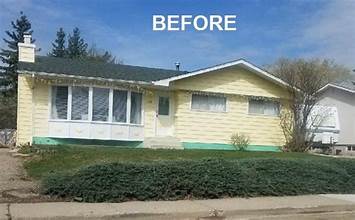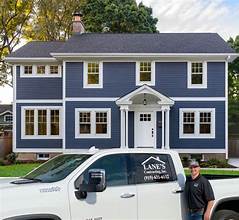As we delve into the world of hardiplank exterior, we uncover a plethora of advantages and design possibilities that make it a sought-after material for homes. From its composition to maintenance tips, this guide will equip you with the knowledge needed to make the most of hardiplank for your exterior needs.
Discover the versatility and durability of hardiplank siding as we navigate through its installation process, design options, and comparisons with other exterior materials.
Introduction to Hardiplank Exterior
Hardiplank exterior is a type of siding material made from a combination of cement, sand, and cellulose fibers. It is known for its durability, versatility, and low maintenance requirements, making it a popular choice for residential and commercial buildings alike.
Composition and Characteristics of Hardiplank
- Hardiplank is composed of cement, sand, and cellulose fibers, which are combined to create a strong and weather-resistant material.
- It is available in a variety of textures and finishes, allowing for customization to suit different architectural styles.
- Hardiplank is resistant to rot, fire, pests, and weather damage, making it a long-lasting and reliable siding option.
Benefits of Using Hardiplank as an Exterior Material
- Low maintenance: Hardiplank requires minimal upkeep and is resistant to fading, cracking, and warping.
- Durability: Hardiplank is designed to withstand harsh weather conditions and maintain its structural integrity over time.
- Versatility: Hardiplank can be painted in a wide range of colors to complement any design aesthetic.
- Fire resistance: Hardiplank is non-combustible, providing added safety and peace of mind for homeowners.
Installation of Hardiplank Siding
Installing Hardiplank siding requires careful attention to detail and the use of the right tools and materials. Proper installation techniques are crucial for ensuring the durability and longevity of your exterior.
Steps Involved in Installing Hardiplank Siding
- Prepare the surface: Make sure the surface is clean, dry, and free of any debris before installation.
- Measure and cut: Measure the dimensions of the area to be covered and cut the Hardiplank siding to fit accordingly.
- Install flashing: Properly install flashing around windows, doors, and corners to prevent water infiltration.
- Attach the siding: Use nails or screws to secure the Hardiplank siding to the exterior, following the manufacturer's guidelines.
- Seal joints: Seal all joints and edges with caulk to prevent moisture from seeping behind the siding.
- Finish the edges: Install trim pieces to finish the edges and create a polished look.
Tools and Materials Required for Installation
- Hardiplank siding
- Nails or screws
- Flashing
- Caulk
- Trim pieces
- Tape measure
- Saw
- Hammer or screwdriver
- Ladder
Importance of Proper Installation Techniques
Proper installation techniques are essential for the longevity of your Hardiplank siding. By following the correct procedures, you can ensure that your siding is securely attached, properly sealed, and protected from the elements. This will not only enhance the aesthetic appeal of your home but also increase its overall durability and value.
Design Options with Hardiplank
When it comes to design options with Hardiplank siding, the possibilities are endless. Hardiplank offers a wide range of styles and textures that can complement any architectural design, from traditional to modern.Hardiplank siding comes in a variety of color options, allowing homeowners to choose the perfect shade to enhance the exterior of their home.
Whether you prefer a classic neutral tone or a bold statement color, Hardiplank has you covered.Using Hardiplank can greatly enhance the curb appeal of a home
With the ability to mimic the look of wood, stone, or stucco, Hardiplank can elevate the overall aesthetic of any property.
Color Options for Hardiplank Exteriors
When it comes to color options for Hardiplank exteriors, homeowners have a wide range of choices to suit their style preferences. Some popular color options include:
- Classic White: A timeless choice that can brighten up any home exterior.
- Earthy Tones: Shades of brown, tan, and gray that can provide a natural and warm look.
- Bold Colors: From deep blues to vibrant reds, homeowners can make a statement with a bold color choice.
- Neutral Hues: Soft grays and muted blues that offer a subtle and sophisticated appearance.
Enhancing Curb Appeal with Hardiplank
Hardiplank siding can be used strategically to enhance the curb appeal of a home in various ways. Some key design options to consider include:
- Vertical Siding: Creating a modern and sleek look by installing Hardiplank vertically.
- Mixed Textures: Adding visual interest by combining different textures of Hardiplank siding.
- Accent Colors: Using contrasting colors to highlight architectural features and add depth to the exterior.
- Trim Details: Incorporating decorative trim elements to frame windows and doors for a polished finish.
Comparing Hardiplank with Other Exterior Materials
When it comes to exterior materials for your home, Hardiplank stands out as a popular choice. Let's take a closer look at how it compares to other common options.
Hardiplank vs. Traditional Wood Siding
Traditional wood siding has been a classic choice for many homeowners, but Hardiplank offers several advantages over it. Hardiplank is more durable and requires less maintenance compared to wood siding, which can be prone to rotting, warping, and insect damage.
Additionally, Hardiplank is fire-resistant, providing an extra layer of safety for your home.
Advantages of Hardiplank over Vinyl Siding
While vinyl siding is a popular and cost-effective option, Hardiplank offers several advantages. Hardiplank is more durable and resistant to impact, making it less likely to crack or break compared to vinyl. It also provides a more authentic wood-like appearance, giving your home a higher-end look.
Durability of Hardiplank vs. Fiber Cement Siding
Both Hardiplank and fiber cement siding are known for their durability, but Hardiplank has the edge in terms of longevity. Hardiplank is resistant to moisture, rot, and pests, making it a low-maintenance option that can last for decades. Fiber cement siding may require more maintenance over time, making Hardiplank a more practical choice for many homeowners.
Closure
In conclusion, hardiplank exterior stands out as a reliable and aesthetically pleasing choice for homeowners looking to enhance their curb appeal while ensuring long-lasting durability. With its array of benefits and design flexibility, hardiplank proves to be a top contender in the realm of exterior materials.
Questions Often Asked
What sets hardiplank apart from other exterior materials?
Hardiplank offers the durability of fiber cement with the versatility of wood siding, making it a popular choice for homeowners.
How frequently should hardiplank siding be maintained?
Regular cleaning and inspections are recommended every 6-12 months to ensure the longevity of hardiplank exterior.
Can hardiplank siding be painted to match different home styles?
Yes, hardiplank can be painted in a variety of colors to complement different architectural designs and preferences.

